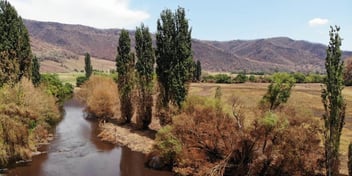Restoring clean waterways after a bushfire
When recovery starts in a bushfire affected region, water utilities are faced with many competing priorities, often including a renewed supply of safe drinking water for communities, as well as helping farmers mitigate surface water pollution so that livestock can stay well watered.
The AWA Victoria Bushfire Recovery Hackathon challenged a team of young water professionals to devise a solution to help farmers mitigate impacts on fire-affected water supplies.
H^3 (Happily Hydrated Heifers) team member Ellie Denson said, in extreme circumstances, help is sometimes initially unavailable, which is why her team focused on devising a system for cleaning dam water that could be easily applied by farmers following bushfire events.
“When catchments are burned by bushfire, the land ends up covered with lots of burned material and, due to the loss of vegetation, the land also becomes highly erodible,” she said.
“When storm events occur, a lot of sediment and ash gets picked up by the rain and dumped into water supplies such as rivers. This leads to polluted rivers that are too dirty to be safely treated by wastewater treatment plants and farm dams that are too dirty for cattle to drink from.
“Water utilities are then left with two problems: they have to figure out how to supply drinking water to their towns and, at the same time, help farmers in their area with supplying water to their cattle, as their dams are polluted.”
Laying the groundwork
Denson said H^3 started with a research journey, exploring the particulars of post-bushfire surface water pollution before designing their solution.
“We did some initial research looking at guides and info-sheets that have been prepared by various government agencies in response to bushfires, as well as checking out some academic papers on the topic," she said.
“Interviews and discussion with water utility employees was also really critical, as we ended up changing the direction we were focusing on in response to some of the things we learned from our interviews.”
The H^3 solution involves reticulating polluted dam water through a silt fence, which works to clean surface water to a standard safe for livestock.
“Our solution focuses mainly on silt fence reticulation. Starting with an already polluted dam, the idea is to continuously pump water out of the dam up hill. Farmers choose to pump water to a location that will allow the water to flow over land and back into the dam,” Denson said.
“An ideal flow path would be a gentle, vegetated slope that will help to slow the water and drop the sediment out before it gets back to the dam. At the top of the hill, farmers can use hay bales or a slotted pipe to spread the water out into a thin sheet as it runs down the hill.
“The main filter component here is to build silt fences. These are the same concept as what we discovered are an effective preventative measure, but instead we use them here in layers to remove as much of the sediment as possible before it runs back into the dam.”
Easy to build, easy to use
Denson said her team’s key aims were to create a solution that is cheap, easy to implement at short notice, low-maintenance and provide safe drinking water for stock.
“Silt fences are easy to build, they are just a piece of shade cloth tied to some short stakes. The fabric barrier slows the water and filters sediment out. This solution uses equipment that is easily available to farmers and can be built very quickly,” she said.
“Furthermore, silt fences are also a great preventative measure, so helping farmers learn how to use them could also help in future. The system can then be used continuously to make the water progressively cleaner until it is of an acceptable quality for stock.
“Another component that can be included to improve the effectiveness of this method is to add alum dosing just before the water runs down the hill, as it will cause the sediment to clump together and settle more easily.”
Denson said the silt fence solution offers farmers an avenue for immediate water pollution mitigation, without having to rely on already overburdened water utilities for help.
“The key part is that farmers should be able to implement the set-up on their own, without assistance from water utilities, and without special equipment so that farmers can implement it within the critical time period of providing drinking water to stock,” she said.
“The solution is a good start towards coming up with ways for farmers to clean their dams of the sediment that collects in them after bushfires. Some additional opportunities include incorporating a ute mounted alum dosing sediment settlement tank.
“This would likely be more effective and faster than our sediment fence solution, however, the drawback is that generally when this happens, it happens to every farmer in the area, so you’ll never have enough mobile assistance units to help them all.
“This brings us back to the advantage of our system, which is that it can be built in a day with equipment available at Bunnings, so it's scalable to as many farmers as who need it.”

